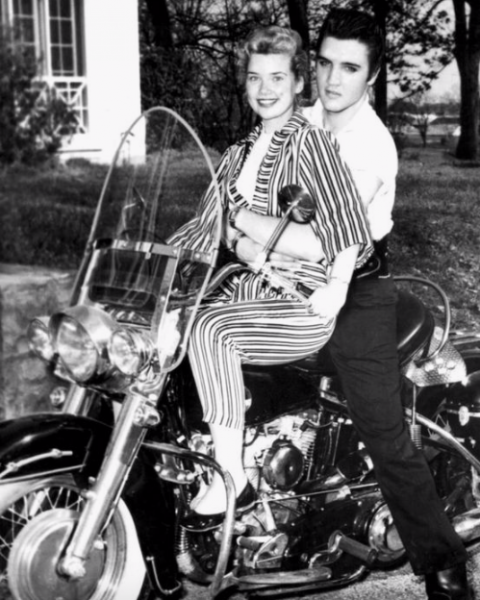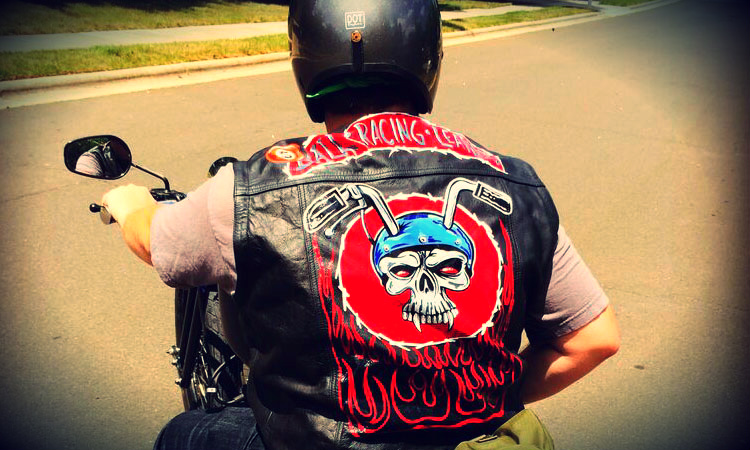Canton veteran who lost leg rides again thanks to customized motorcycle
By Wayfarer | | General Posts
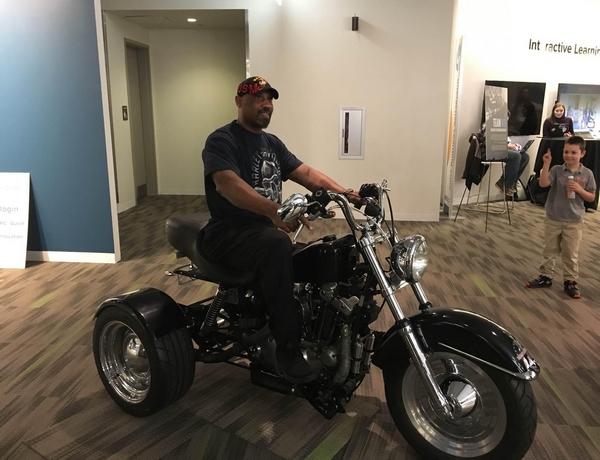 by Kelly Byer from https://www.cantonrep.com
Challenge America: Makers For Veterans helped Charles Zollicoffer get back on the road.
Challenge America: Makers For Veterans helped Charles Zollicoffer ride a motorcycle for the first time in eight years.
More importantly, he said, the fall program renewed his faith in humanity.
“I was left for dead on the side of the road,” he said. “So, during my time in this last seven or eight years, I have lost a lot of faith in people. A lot.”
In 2011, a drunken driver pulled in front of Zollicoffer’s 1995 Kawasaki motorcycle on state Route 800. The now retired U.S. Marine Corps and Army National Guard veteran had completed three tours in Iraq and was scheduled for deployment to Afghanistan.
Another person came across the early morning wreck and stopped to help. Zollicoffer, a 53-year-old Canton resident, spent months in a coma and had his left leg amputated at the hip.
This past Veteran’s Day, he received a modified trike at the Makers For Veterans closing ceremony. His family’s safety concerns had kept Zollicoffer from pursuing a costly trike, but they talked and accepted what it meant to him beforehand.
He’s taken a few rides.
“I can’t even describe the feeling, when you get that wind blowing through your hair,” joked Zollicoffer, who has a shaved head.
Makers for Veterans
The Colorado-based nonprofit Challenge America began the Makers for Veterans program (CAMVETS) in 2019. It brought together volunteers with various expertise to solve challenges posed by veterans.
Dallas Blaney, executive director of Challenge America, said the inspiration came from a similar initiative in Israel. Challenge America members participated in the international program and wanted to recreate the experience in the United States.
Blaney described it as “human-centered design applied to the veterans space.” The process begins by asking participants, selected from across the nation, what they want to do that they haven’t been able to.
“That forces the veterans to frame their challenges in a positive way,” Blaney said.
A team — built “from scratch” — with skills relevant to the individual’s challenge then meet at a kickoff event. That is followed by about eight weeks of planning and work culminating in a three-day workshop.
CAMETS then works with the U.S. Department of Veterans Affairs and other partners to identify prototypes to patent and undergo additional product development.
“So that we can get those promising solutions out to market where other veterans and civilians, too, can benefit from these things,” Blaney said.
CAMVETS coordinated a spring and fall program. From 17 total projects, Blaney said, the partners produced 15 working prototypes and, so far, filed for five provisional patents.
Blaney said a digital service dog application designed to help a veteran with post-traumatic stress disorder is expected to be the first product ready for market.
Both programs were held in the Cleveland area, not far from where Blaney grew up. He said the region has a great blend of medical, manufacturing, entrepreneurial, academic and innovative institutions.
The Cleveland Clinic, Bio Enterprise and St. Edward High School are some of CAMVETS’ partners.
“It just seemed like such an amazing fit, and it’s a very friendly place to do business,” Blaney said.
The nonprofit likely will host another program in Northeast Ohio this year, but only one. He said CAMVETS plans to expand to a new city.
Zollicoffer’s custom trike
De Ann Williams, executive director of the Stark County Veterans Service Commission, heard about a CAMVETS opening during a conference and nominated Zollicoffer. It was the first she’d heard about the organization, but she thought the program might produce a longer-lasting prosthetic leg.
Zollicoffer used to play basketball and entered the program thinking he’d leave with a prosthetic for athletic activities.
“With the level of my amputation, that was close to impossible,” he said. “So they started asking questions.”
Zollicoffer, who grew up riding motorcycles, then told his team he’d like to ride again.
“As a motorcycle enthusiast myself, I understood and respected that,” Williams said.
Zollicoffer worked ’hand-in-hand” with his team as the plan evolved — from modifying his prosthetic leg to modifying a three-wheeled motorcycle. However, he said he wasn’t privy to the end product until the Veteran’s Day reveal.
When he was asked to visit a Harley Davidson store as the project wound down, Zollicoffer began to wonder if he’d get a new trike. He later learned that sitting on a $35,000 motorcycle was more for measurement.
The engineers, students and other makers on Team Z turned a two-wheel 1972 Harley Davidson into a trike by replacing the rear portion with wheels from a 1978 Mustang. They also moved the typical, left-side motorcycle gears to the right.
“So, it was a totally customized job,” Zollicoffer said.
Community comes together
After he saw the trike, Zollicoffer saw the executive director of the Stark County Veterans Service Commission.
“I turned around and there’s De Ann standing there,” he said. “That’s when it became clear to me that the whole outreach team got together and they did this thing.”
CAMVETS has paid the “lion share” of most projects, Blaney said. The local commission, though, was tasked with raising $5,000 to buy the bike, which was complemented by donated parts.
Williams said she believes the plan to have the bike donated didn’t work out, so the commission reached out to area service organizations. They had the money within a few days.
“I was just beside myself,” she said. “I couldn’t believe the community came together like that.”
The Disabled American Veterans (DAV) Chapter 38 was the major donor. Others were American Legion Post 548, American Veterans Post 124, and Coyote Motorsports.
DAV Commander David May said the project aligned with the group’s mission to assist disabled veterans.
“We’re happy to do it,” he said.
Those involved with CAMVETS said they were glad to learn of the program and plan to volunteer or recommend it to other veterans in the future. Zollicoffer said he made “lifelong friends.”
“We’ll definitely stay in touch with CAMVETS,” Williams said. “I think that that’s definitely going to be a partnership that I hope lasts for a long time.”
by Kelly Byer from https://www.cantonrep.com
Challenge America: Makers For Veterans helped Charles Zollicoffer get back on the road.
Challenge America: Makers For Veterans helped Charles Zollicoffer ride a motorcycle for the first time in eight years.
More importantly, he said, the fall program renewed his faith in humanity.
“I was left for dead on the side of the road,” he said. “So, during my time in this last seven or eight years, I have lost a lot of faith in people. A lot.”
In 2011, a drunken driver pulled in front of Zollicoffer’s 1995 Kawasaki motorcycle on state Route 800. The now retired U.S. Marine Corps and Army National Guard veteran had completed three tours in Iraq and was scheduled for deployment to Afghanistan.
Another person came across the early morning wreck and stopped to help. Zollicoffer, a 53-year-old Canton resident, spent months in a coma and had his left leg amputated at the hip.
This past Veteran’s Day, he received a modified trike at the Makers For Veterans closing ceremony. His family’s safety concerns had kept Zollicoffer from pursuing a costly trike, but they talked and accepted what it meant to him beforehand.
He’s taken a few rides.
“I can’t even describe the feeling, when you get that wind blowing through your hair,” joked Zollicoffer, who has a shaved head.
Makers for Veterans
The Colorado-based nonprofit Challenge America began the Makers for Veterans program (CAMVETS) in 2019. It brought together volunteers with various expertise to solve challenges posed by veterans.
Dallas Blaney, executive director of Challenge America, said the inspiration came from a similar initiative in Israel. Challenge America members participated in the international program and wanted to recreate the experience in the United States.
Blaney described it as “human-centered design applied to the veterans space.” The process begins by asking participants, selected from across the nation, what they want to do that they haven’t been able to.
“That forces the veterans to frame their challenges in a positive way,” Blaney said.
A team — built “from scratch” — with skills relevant to the individual’s challenge then meet at a kickoff event. That is followed by about eight weeks of planning and work culminating in a three-day workshop.
CAMETS then works with the U.S. Department of Veterans Affairs and other partners to identify prototypes to patent and undergo additional product development.
“So that we can get those promising solutions out to market where other veterans and civilians, too, can benefit from these things,” Blaney said.
CAMVETS coordinated a spring and fall program. From 17 total projects, Blaney said, the partners produced 15 working prototypes and, so far, filed for five provisional patents.
Blaney said a digital service dog application designed to help a veteran with post-traumatic stress disorder is expected to be the first product ready for market.
Both programs were held in the Cleveland area, not far from where Blaney grew up. He said the region has a great blend of medical, manufacturing, entrepreneurial, academic and innovative institutions.
The Cleveland Clinic, Bio Enterprise and St. Edward High School are some of CAMVETS’ partners.
“It just seemed like such an amazing fit, and it’s a very friendly place to do business,” Blaney said.
The nonprofit likely will host another program in Northeast Ohio this year, but only one. He said CAMVETS plans to expand to a new city.
Zollicoffer’s custom trike
De Ann Williams, executive director of the Stark County Veterans Service Commission, heard about a CAMVETS opening during a conference and nominated Zollicoffer. It was the first she’d heard about the organization, but she thought the program might produce a longer-lasting prosthetic leg.
Zollicoffer used to play basketball and entered the program thinking he’d leave with a prosthetic for athletic activities.
“With the level of my amputation, that was close to impossible,” he said. “So they started asking questions.”
Zollicoffer, who grew up riding motorcycles, then told his team he’d like to ride again.
“As a motorcycle enthusiast myself, I understood and respected that,” Williams said.
Zollicoffer worked ’hand-in-hand” with his team as the plan evolved — from modifying his prosthetic leg to modifying a three-wheeled motorcycle. However, he said he wasn’t privy to the end product until the Veteran’s Day reveal.
When he was asked to visit a Harley Davidson store as the project wound down, Zollicoffer began to wonder if he’d get a new trike. He later learned that sitting on a $35,000 motorcycle was more for measurement.
The engineers, students and other makers on Team Z turned a two-wheel 1972 Harley Davidson into a trike by replacing the rear portion with wheels from a 1978 Mustang. They also moved the typical, left-side motorcycle gears to the right.
“So, it was a totally customized job,” Zollicoffer said.
Community comes together
After he saw the trike, Zollicoffer saw the executive director of the Stark County Veterans Service Commission.
“I turned around and there’s De Ann standing there,” he said. “That’s when it became clear to me that the whole outreach team got together and they did this thing.”
CAMVETS has paid the “lion share” of most projects, Blaney said. The local commission, though, was tasked with raising $5,000 to buy the bike, which was complemented by donated parts.
Williams said she believes the plan to have the bike donated didn’t work out, so the commission reached out to area service organizations. They had the money within a few days.
“I was just beside myself,” she said. “I couldn’t believe the community came together like that.”
The Disabled American Veterans (DAV) Chapter 38 was the major donor. Others were American Legion Post 548, American Veterans Post 124, and Coyote Motorsports.
DAV Commander David May said the project aligned with the group’s mission to assist disabled veterans.
“We’re happy to do it,” he said.
Those involved with CAMVETS said they were glad to learn of the program and plan to volunteer or recommend it to other veterans in the future. Zollicoffer said he made “lifelong friends.”
“We’ll definitely stay in touch with CAMVETS,” Williams said. “I think that that’s definitely going to be a partnership that I hope lasts for a long time.”So This is What Complete Streets Comes Down To?
By Bandit | | General Posts
The Complete Streets Act of 2019, U.S. House Bill 3663, is creating a lot of rhetorical questions on our part. In NMA E-Newsletter #552, the title question was “An Appropriate Balance for Whom?” in response to the bill’s declaration that the needs of walkers and bike riders must be accommodated before those of drivers on all new and improvement road projects. That edict would force a script flip of how Americans travel daily.
A recent article in the ITE (Institute of Transportation Engineers) Journal gives us a glimpse into one such bizarre road design. Let’s start with two images of the advisory bike lane (ABL) concept outlined in the Journal:
There is a single lane for two-way motorized traffic, and two bike lanes outside of that center lane dedicated to bicyclists heading in opposing directions. When vehicles approach each other head-on in the middle, the drivers both move into the bike lanes temporarily. No safety issues there for bicyclists, and no blame for motorists who are trying to avoid a direct collision without bumping angry, blind-spot riders off of their bikes, right?
We referred to ABLs as a concept a bit earlier. But according to Michael Williams, a consultant writing for the ITE Journal, this design ─ which he also refers to as “edge lane roads” ─ is operational in more than two dozen locations in North America. The application is targeted for urban or suburban roads with average annual daily traffic of 6,000 vehicles or less.
And, one presumes, a proportional number of bicyclists. That would be, according to data on daily modes of transportation from the 2016 U.S. Census, approximately 20 cars or trucks for every individual bicycle on the road.
That ratio significantly understates the number of vehicles vs. bicyclists on the road at any given time, considering that the average daily trip (distance and time) by car is longer than by bicycle. At the recent national conference on Vision Zero and Road Diets sponsored by the NMA in Los Angeles, attendees played a little game. When looking out the glass windows of our meeting venue onto bustling Venice Boulevard, which recently had gone through its own forced restriction of car lanes, we counted five bicyclists traveling in the west bike lane over the course of about an hour.
This is why we must defeat the Complete Streets Act of 2019 and similar efforts to restrict driving to absurd levels. Watch for continuing NMA email alerts and e-newsletters about the role you can play in helping us do just that.
|
|
On New Years Eve the National Motorcycle Museum drew the three winners in the 2019 Fundraiser Bike Giveaway.
By Bandit | | General Posts
MOTORCYCLE RIDER FOUNDATION PRIORITIES FOR 2020
By Bandit | | General Posts
The Motorcycle Riders Foundation: 2019 Legislative & Regulatory Priorities At the 2018 Motorcycle Riders
Foundation’s (MRF) 34th annual Meeting of the Minds Conference held in Denver, CO, a Legislative Strategy Session was hosted by the MRF’s Legislative Committee. The purpose of the Session was to establish and prioritize the MRF’s Federal Legislative Agenda for 2019. These priorities are categorized below. Note that at any time, an item may move to a different category depending on the likelihood of activity. This list should remain fluid and can be adaptable depending on the issue and political environment.
HIGH PRIORITY
Continue to lobby for the passage of legislation (H.Res.318 & S.Res.154) promoting public awareness of and condemning instances of motorcycle profiling by law enforcement officials
• Advocate for targeted changes to the Renewable Fuel Standard including the following actions:
o The indefinite and universal availability of approved fuel blends, containing no more than 10 percent ethanol by volume.
o Additional research and independent studies concerning the effects of higher blends of ethanol on motorcycles as well as targeted consumer education programs
o Where higher ethanol blends are available, ensure separate pumps (i.e. no blender pumps) to minimize the risk of damage to motorcycle engines • Advocate and monitor for motorcyclists concerning laws and regulations related to connected and autonomous vehicles, specifically, (AV START Act, S.1885);
o Required testing for motorcycle recognition and responsiveness
o Strong standards to ensure the safety of motorcycle users as it relates to electronic and cyber security systems
o The inclusion of motorcyclists’ perspectives in discussions regarding Intelligent Transportation System (ITS)
o Clarification of the rights of data ownership of any recorded data in the context of connected and autonomous vehicles
• Fully engage the EPA & Congress on any activity related to motorcycle emission regulations (i.e. RPM Act – H.R.350 & S.203)
• Work with appropriate stakeholders concerning the federal definition of a motorcycle, ensuring that crash and fatality statistics continue to be separate from other classes of vehicles including autocycles, nonmotorcycle powered vehicles such as mopeds, scooters, and various cabin-based steering wheel type vehicles
• Consider limiting funding of any federal government entity with increasing involvement in advocating for a universal helmet law or similar initiatives
• Continue to promote our theme of crash avoidance versus safer crashing urging NHTSA to focus on crash prevention and rider education
• Fiercely oppose any federal mandatory helmet, apparel or conspicuity standards
• Pursue legislative language that any collected vehicle data is property of the consumer and in which the consumer has the option to opt out of having their personal data communicated to interested parties
• Pursue and monitor efforts related to the next highway bill (expiring in 2020). Ensure the following provisions are included: o Motorcycle Education & Awareness Program Grant Funding
o Continuation of the NHTSA Lobbying Ban
o Continuation of Motorcycle Advisory Council (MAC) to advise the FHWA
o Oppose any motorcycling related federal blackmails or federal sanctions
o Monitor for any action that would negatively impact motorcycles, motorcycling, and motorcyclists
o Continuation of ban on federal funding for Motorcycle Only Checkpoints
MEDIUM PRIORITY
• Pursue safer roadway design strategies in federal infrastructure legislation or discussions (i.e. MAC)
• Oppose any motorcycling, motorcycle, or motorcyclist-based discriminatory legislation or rules proposed by the U.S. Congress or by any federal agency
• Monitor and ensure that the term “vulnerable roadway users” does not include motorcyclists
MONITOR
Work to discourage ALL forms of distracted driving • SAE Motorcycle Roadside Sound Testing (addressed by individual states)
• Continue participation in motorcycle related activity in the European Union, United Nations, and Canada informing membership of key developments
• Continue monitoring any federal studies concerning motorcycles (i.e. Federal Crash Causation Study MSF Naturalistic Study)
• Monitor and strongly oppose any federal standard proposing stamping and certifying of motorcycle exhaust systems
• Monitor private and public organizations that oppose the legislative agenda or mission of the MRF • Monitor fair tolling concepts on federally funded roadways and projects supported by federal bonds
• Monitor and support federal efforts to study and review the benefits and concerns of lane splitting and lane filtering
• Monitor and respond to federal legislative or regulatory activity concerning the usage of the terms gang, club, known associate, and associate when referring to motorcyclists
• Monitor and report on any litigation related to motorcycle emissions violations
JOIN THE MRF, QUICK AND KEEP US FREE: WWW.mrf.org
Damon Motorcycles and BlackBerry QNX Revolutionize Motorcycling with the Introduction of Hypersport Pro Electric Superbike
By Wayfarer | | General Posts
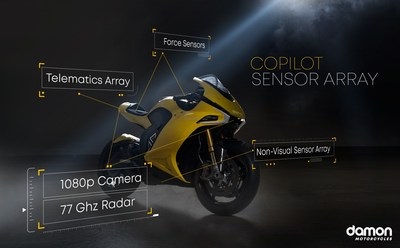
– Damon to unveil flagship motorcycle, the ‘Hypersport Pro at CES 2020 in BlackBerry Limited’s (NYSE: BB; TSX: BB) booth #7515, North Hall.
– #FutureOfMotorcycling Interactive Experience will be open to all CES attendees in the BlackBerry booth from January 7 – 10, 2020
VANCOUVER, British Columbia and WATERLOO, Ontario, Jan. 3, 2020 /PRNewswire/ — Damon Motorcycles announced today that its CoPilot™ advanced warning system will be powered by BlackBerry QNX technology across its entire line-up of advanced electric motorcycles.
As part of the agreement, Damon has licensed BlackBerry QNX technology, including its industry-leading real-time operating system to serve as the safe and secure foundation for the Damon CoPilot warning system on its new flagship electric motorcycle.
Damon will unveil this disruptive, limited edition superbike, the Hypersport Pro™, and open reservations to the public online and at CES at 10:00am PST, January 7th. In BlackBerry’s booth, attendees will also be able to experience Damon’s next generation motorcycle first-hand in the #FutureOfMotorcycling Interactive Experience, a rideable, leaning stationary motorcycle that uses virtual reality to showcase the motorcycle’s unique features on the show floor.These features include its powerful all-electric performance, its CoPilot advanced warning system, and Shift™, its patented rider ergonomics that lets riders electronically adjust the Hypersport’s riding position while in motion. CoPilot uses radar, cameras and non-visual sensors to track the speed, direction and velocity of moving objects around the motorcycle. Attendees can book a time slot to experience it at CES by visiting damonmotorcycles.com/VR.
“We’re on a mission to unleash the full potential of personal mobility for the world’s commuters,” said Jay Giraud, Chief Executive Officer of Damon Motorcycles. “To address this, we spent the last three years developing an AI-powered, fully connected, e-motorcycle platform that incorporates CoPilot, our proprietary 360º warning system. By building it on BlackBerry’s best-in-class technology that is safety certified, Damon motorcycles will be the safest, most advanced electric motorcycle in the market.”
“With its advanced collision warning system, Damon’s new Hypersport Pro is a game-changing model for the motorcycle industry,” said Grant Courville, VP, Product Management and Strategy, BlackBerry QNX. “We’re absolutely thrilled to have them in our booth and look forward to showing off the highly-secure software that delivers enhanced situational awareness and increased peace of mind for riders. BlackBerry QNX is leading the way in next-generation mobility systems by providing a safe and secure platform for connected vehicles and beyond and we’re proud to work with Damon on this exciting advancement.”
BlackBerry QNX is a leader in delivering trusted embedded operating systems and development tools to companies for which failure is not an option. Committed to the highest safety, reliability and security standards, BlackBerry QNX has developed a portfolio of software and services with a proven record of helping developers deliver complex and connected next generation products. BlackBerry QNX technology is trusted in over 150 million vehicles and millions of embedded systems, including medical, industrial automation, robotics, energy, defense and aerospace applications. For more information on BlackBerry QNX, please visit blackberry.qnx.com.
With performance specs to be released at CES 2020, Damon’s industry-leading advanced prototypes are set to hit the roads in mid-2020 to the world’s largest mobility segment well overdue for a safer, smarter, zero emission solution. For more information on Damon Motorcycles, please visit damonmotorcycles.com.
Seven Major Smart City Trends For 2020
By Bandit | | General Posts
It’s the turn of a new decade, and following a wild year of transformation in 2019, the 2020s are bound to face more innovation, speculation and security risks than ever before.
To help start the year off right, Smart Cities Dive has gathered insights from industry leaders to identify the trends that are expected to influence the smart city space in 2020.
1. Investors will pump more money into flying cars
The new year will likely be momentous for investments in electric vertical take-off and landing aircrafts (eVTOL), or “flying cars.”
Uber pledged to start testing its Uber Air flying taxi service in 2020, and even projected eVTOLs will be mainstream as soon as 2023. The company’s Elevate Summit in June also cemented its promise to stir things up in the industry by announcing plans to conduct public tests of the vehicles in Dallas, Los Angeles, and Melbourne, Australia, on top of showcasing its plans for “skyports” where the vehicles would land and take off.
2. Cities will see fewer scooter operators on streets as companies consolidate
The rapid descent of scooter operators on city streets will slow down in 2020. Instead, the industry should expect to experience more consolidation.
That trend is already taking shape in Washington, DC, one of the first cities to majorly embrace dockless bikes and scooters.
3. More cities will turn to building electrification
It’s no secret buildings are responsible for a massive portion of city emissions. San Jose, CA became the largest city in the country this year to ban natural gas infrastructure from many new residential buildings. The city’s ordinance went into effect on Jan. 1, and includes a requirement to have 70% electric vehicle (EV) capable parking spaces; 20% EV ready parking spaces; and 10% EV supply chain equipment spaces.
The San Jose ordinance followed Berkeley, CA, which was the first U.S. city to pass such a ban in new buildings.
4. City dwellers will demand stronger data privacy
One of the most widely-watched city data privacy debates in 2019 was with Sidewalk Labs’ proposed Quayside project. The futuristic smart city received some of its strongest criticism due to concerns over data privacy, and eventually promised not to sell personal data or leverage it for advertising in response to pushback.
5. Cities will crack down on cyberattacks
The past year was also marked by a number of cyberattacks against city governments, which should lead to more cities cracking down on how they protect their systems.
Cities have increasingly become targets for attacks due in part to their lack of substantial cybersecurity networks, with most states allocating under 3% of their IT budgets to cyberthreat prep.
6. Mobility hubs and car-free zones will be more widely considered
Major strides were made to discourage car use in 2019, particularly by eliminating cars in some of cities’ busiest areas. London, for example, planned a car-free day smack dab in the city center. And the San Francisco Municipal Transportation Agency Board of Directors approved a plan to ban cars along the downtown area of Market Street, encouraging biking and bus trips instead. New York recently banned cars on 14th Street in Manhattan for a dedicated “busway,” and Washington, DC is even exploring a car-free zone.
7. The climate wakeup call for greener (and bigger) investments will grow
The summer of 2019 was a “wakeup call” for many cities, according to Bloomberg Associates’ Adam Freed.
The extreme heat forced leaders to recognize the “need to correct the catastrophe of urban planning over the past century that has turned our cities into ovens and focus on ways to provide urban cooling that doesn’t increase our air conditioning load,” he said.
–from TechnocracyNews.com
Upbeat Bikernet Weekly News for January 2, 2020
By Wayfarer | | General Posts
Hey,
I like this year already. It’s going to be whacky and wonderful. It’s just the 2nd day of January and the world is back in business. We’re all doing what we did a couple of weeks ago, going about taking the trash out, feeding the dog and heading off to work.
Hell, I have all the Deadlines for Cycle Source Magazine etched into my 2020 Pin-Up calendar. We need to break the mold for 2020. Do something crazy. I’m going to go back to Bonneville this year with something completely different.
And I’m trying to buy a little place in Deadwood, SD and change up my life some. I hope everyone finds new challenges, new hope, new adventures and new love in 2020.
CLICK HERE TO READ THE BIKERNET WEEKLY NEWS
Join the Cantina today – https://www.bikernet.com/pages/custom/subscription.aspx – more fun, tech, news, views, reports and reviews
Buy Custom Art Leather gear at 5-Ball Shop – http://shop.bikernet.com/
Kawasaki Raises Nearly $100,000 For Charities in 2019
By Wayfarer | | General Posts

Foothill Ranch, Calif. – Kawasaki Motors Corp., U.S.A., has proudly supported several local and national charities in raising hundreds and thousands of dollars in 2019, supporting worthy causes with cash and product donations, as well as VIP racing fan experiences at Monster Energy Supercross. The charitable efforts of Kawasaki Motors Corp., U.S.A. and its employees have nearly exceeded $100,000 in value.
“The charities Kawasaki has chosen to work with are a fundamental part of our community,” said Bill Jenkins, SVP Sales and Operations. “We’re thrilled to have the opportunity to support charities such as the Boys and Girls Club of South Coast Area, the CHiPs for Kids Toy Drive, Honoring our Wounded Military (HOWM), Orange County Police Canine Association, and The ALS Association – Orange County Chapter. We have supported these organizations with both financial and product donations for their causes to help our community where we can.”
Kawasaki’s efforts helped to raise $45,000 for the Boys and Girls Club of South Coast Area by donating two 2020 Jet Ski® STX®160 personal watercraft and two VIP Monster Energy Kawasaki Team Supercross experience. The items were auctioned off at the Boys and Girls Club of South Coast 2019 Great Futures Gala.
With the holidays fast approaching, Kawasaki employees always make sure to support those in need by providing toys and other gifts for the California Highway Patrol’s ninth annual CHiPs for KIDS toy drive. In 2019, Kawasaki team members stepped up once again to help deliver a happy holiday to families in Southern California.
Amongst the many important charitable causes Kawasaki supports is the Honoring Our Wounded Military Foundation. For 2019, Kawasaki donated a 2019 Jet Ski® Ultra® LX for the Honoring Our Wounded Military live auction, that helped to raise $40,000, which enabled the foundation to achieve more than $195,000 in donations for 2019.
The ALS Association’s Walk To Defeat event became close to the hearts of many Kawasaki employees in 2019, with many participating on Team Tamura in the ALS Association — Orange County Chapter event. Kawasaki helped to raise more than $1,300 for the organization in tribute to former Kawasaki President Yoshi Tamura, helping ALS Association — Orange County Chapter raise more than $283,000 in 2019.
Kawasaki also raised $1,500 for the Orange County Police Canine Association in 2019.
And as 2019 comes to an end the Kawasaki Motors Corp. Charitable Match Contribution Program employees have additionally raised nearly $10,000 for various charities serving an array of causes across the country.
LIVALL Launches and Debuts New Smartphone-Connected Cycling Safety Helmet at 2020 International CES
By Wayfarer | | General Posts
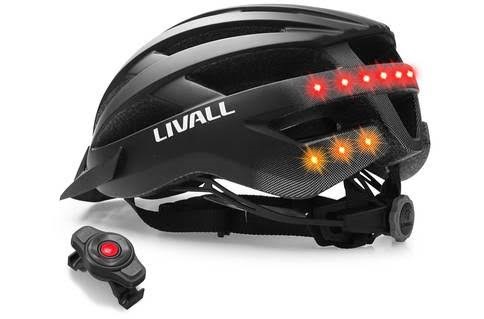
With smart lighting, hands-free operation, fall detection, voice navigation, SOS alarm, and more, the breakthrough new LIVALL BH51M Neo helmet is a quantum leap forward in safety and protection for cyclists
LAS VEGAS, Jan. 02, 2020 (GLOBE NEWSWIRE) — CES (#44513, Hall D, Sands) – LIVALL, a pioneer in smart and safe helmets for cyclists and outdoor enthusiasts, today announced the U.S. product launch and debut of the BH51M Neo to their current line of award-winning smart and safe helmets at the 2020 International CES. In booth #44513, Hall D, Sands LIVALL will demo and showcase their entire line of helmets during the duration of CES from January 7–10, 2020.
LIVALL’s helmets combine visibility with connectivity for commuter and leisure cyclists. The company’s newest smartphone-connected helmet specifically addresses the needs of E-Bike, E-scooter and Electric motorcycle riders. LIVALL’s RS1 helmet is a smart helmet specifically designed for skiing, snowboarding, and other outdoor winter activities.
Debuting in the U.S. at CES, the new BH51M Neo, is a robust, waterproof, fashionable smart helmet that is simple-to-use, comfortable, and packed full of genuinely useful smart tech, including all the existing features of its multi-award-winning predecessor, the BH51M.
“We are delighted to debut this game-changing new connected smart helmet at CES 2020; a show that has evolved to become the perfect fusion of technology and mobility in recent years,” said Bryan Zheng, Founder and CEO, of LIVALL. “In all facets of transportation safety is the preeminent concern, and this is especially true for cyclists who are exposed and constantly in harm’s way. LIVALL aims to create a safe cycling ecosystem; for us, safety is the ultimate luxury. The new BH51M Neo represents a quantum leap forward in safety and protection for the everyday cyclist, and all of us at LIVALL are proud to bring this breakthrough new safety innovation to the cycling and urban mobility community.”
New Features – exclusive to the BH51M Neo:
Front and Brake Warning Lights
The front warning lights work together with the 270° taillights, to protect the user’s security in all directions. When the built-in gravity acceleration sensor detects a significant deceleration, the front and taillights will be highlighted for eight seconds to draw front and rear vehicles’ and pedestrians’ attention.
Auto-Off and Anti-Loss Alarm
Auto-off ensures maximum battery longevity, turning off automatically when the helmet is disconnected from the phone and inactive for 15 minutes. Anti-loss alarm is activated when the helmet is connected to your phone and the distance between helmet and phone exceeds 15m, both the helmet and phone will alarm.
Key Features of the BH51M Neo include:
- Smart Lighting (Automatic Sensor Lighting / Wireless Turn Signals) – Smart lighting integrates adaptive technology to ensure your visibility in dark conditions. Operate wireless LED turn signals via handlebar remote control to alert traffic of turning direction for enhanced visibility and rider safety.
- Fall Detection – In the event of an accident, the emergency system will kick in automatically and send your GPS location to your emergency contacts.
- Press for SOS – If in distress, press the red button on the remote for five seconds and your emergency contacts will receive an alert message with your GPS location.
- One-Click Answer – Answer phone calls using the remote control and enjoy clear sound both ways with the helmet’s built-in Bluetooth speakers and wind-proof microphone.
- PTT Walkie-Talkie – Easily communicate with your fellow cyclists using the Walkie-Talkie function when riding in a group.
- Voice Navigation – Listen to GPS voice navigation via the built-in speaker with your connected smartphone.
- Stereo speakers – Quality music, audiobook and podcast playback is delivered through Bluetooth stereo speakers strategically placed above the ears, allowing you to stay alert to surrounding traffic.
- Compatible with Strava, iHealth and Siri through the LIVALL Riding app.
The BH51M Neo will retail with an MSRP of $169.00 USD on Amazon.com and is available in graphite black or sandstone grey.
Meetings/Demos At CES:
Members of the media and industry contacts wishing to book a specific date/time for demo and briefing can contact Megan Kathman, Skyya PR at megan@skyya.com and 651-785-3212. Those seeking images, B-Roll, and additional information, can also access the LIVALL press kit.
About LIVALL:
Located in Shenzhen, LIVALL Tech Co., Ltd. is adept at developing, designing and manufacturing fashionable and multifunctional patented helmetphones to maximize riders’ safety. With more than 170 patents and advanced equipment, LIVALL has strict standards and massive production capacity to meet the huge market demand. With a primary focus on product innovation and product experience, this firm has received recognition and trust from the industry and the users. Furthermore, it obtained more than 30 awards and over 10 international certifications including CPSC1203, EN1078, CE, FCC, NCC, ROHS, BQB, etc.
Segway tries to be sexy at CES, presents new electric motorcycle
By Wayfarer | | General Posts

by Chris Matyszczyk from https://www.zdnet.com/
Will this be the great victor at CES? Oh, please let that happen.
Admit it, you’ve pitied them.
The tourists, the mailpersons, the mall cops, the aging techies who now resent the future, they’re all regularly seen on Segways. Some, perhaps in a vain attempt to salvage their image, even wear a crash helmet while they ride the much-derided machine.
In recent times, though, Segway was bought by China’s Ninebot. It’s started to develop robots. Well, robotic heads that ride on Segways.
Now, though the company wants to make you drool and not because you’re laughing so much. It wants every attendee at CES 2020 to be talking about nothing other than the enormous strides Segway has made toward being alluring.
Just before Christmas it released a (possibly) dynamic video of its new Apex.
This is an electric motorbike, one that you can ride on a track. Yes, with no one else there but a camera crew.
Some may be moved that there is only one wheel at the front and one at the back.
More may be excited by the idea that this seems like a bike they’d actually be happy to be seen on, even beyond an enclosed track. It is alleged to be capable of going of going from 0-60 in 2.9 seconds and reaching 125 mph.
Some bike aficionados may, however, endure qualms. The Apex sounds less like a bike and more like a one-person metalwork factory. Moreover, the rider in the video doesn’t make it look quite like the muscly monsters that occasionally overtake me on the freeway going 100 mph. (I’m going 65, honest.) He doesn’t lean over very far, does he?
Perhaps, though, it’s a fine bike for our precarious times, one that melds dynamism and sanctimony in one glorious ride.
Naturally, this is being billed as a concept vehicle. But when excitement builds at CES, the momentum can become uncontrollable. As was witnessed last year with the award, unaward and award again of a truly innovative — so I’m reliably informed — sex toy.
Soon, we might be living in a world where Segway Apex’s are disturbing Tesla drivers on the freeway.
What could be more beautiful than that?






